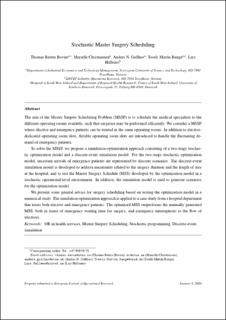| dc.contributor.author | Bovim, Thomas | |
| dc.contributor.author | Christiansen, Marielle | |
| dc.contributor.author | Gullhav, Anders Nordby | |
| dc.contributor.author | Range, Troels Martin | |
| dc.contributor.author | Hellemo, Lars | |
| dc.date.accessioned | 2022-09-27T07:39:22Z | |
| dc.date.available | 2022-09-27T07:39:22Z | |
| dc.date.created | 2020-06-17T08:14:51Z | |
| dc.date.issued | 2020 | |
| dc.identifier.citation | European Journal of Operational Research. 2020, 285 (2), 695-711. | en_US |
| dc.identifier.issn | 0377-2217 | |
| dc.identifier.uri | https://hdl.handle.net/11250/3021614 | |
| dc.description.abstract | The aim of the Master Surgery Scheduling Problem (MSSP) is to schedule the medical specialties to the different operating rooms available, such that surgeries may be performed efficiently. We consider a MSSP where elective and emergency patients can be treated in the same operating rooms. In addition to elective-dedicated operating room slots, flexible operating room slots are introduced to handle the fluctuating demand of emergency patients. To solve the MSSP, we propose a simulation-optimization approach consisting of a two-stage stochastic optimization model and a discrete-event simulation model. For the two-stage stochastic optimization model, uncertain arrivals of emergency patients are represented by discrete scenarios. The discrete-event simulation model is developed to address uncertainty related to the surgery duration and the length of stay at the hospital, and to test the Master Surgery Schedule (MSS) developed by the optimization model in a stochastic operational-level environment. In addition, the simulation model is used to generate scenarios for the optimization model. We present some general advice for surgery scheduling based on testing the optimization model in a numerical study. The simulation-optimization approach is applied to a case study from a hospital department that treats both elective and emergency patients. The optimized MSS outperforms the manually generated MSS, both in terms of emergency waiting time for surgery, and emergency interruptions to the flow of electives. | en_US |
| dc.language.iso | eng | en_US |
| dc.publisher | Elsevier | en_US |
| dc.rights | Attribution-NonCommercial-NoDerivatives 4.0 Internasjonal | * |
| dc.rights.uri | http://creativecommons.org/licenses/by-nc-nd/4.0/deed.no | * |
| dc.subject | Discrete-event simulation | en_US |
| dc.subject | Stochastic programming | en_US |
| dc.subject | Master Surgery Scheduling | en_US |
| dc.subject | OR in health services | en_US |
| dc.title | Stochastic master surgery scheduling | en_US |
| dc.title.alternative | Stochastic master surgery scheduling | en_US |
| dc.type | Peer reviewed | en_US |
| dc.type | Journal article | en_US |
| dc.description.version | acceptedVersion | en_US |
| dc.rights.holder | This is the author accepted manuscript. The VoR is avaliable here: https://doi.org/10.1016/j.ejor.2020.02.001 | en_US |
| dc.source.pagenumber | 695-711 | en_US |
| dc.source.volume | 285 | en_US |
| dc.source.journal | European Journal of Operational Research | en_US |
| dc.source.issue | 2 | en_US |
| dc.identifier.doi | 10.1016/j.ejor.2020.02.001 | |
| dc.identifier.cristin | 1815867 | |
| cristin.ispublished | true | |
| cristin.fulltext | postprint | |
| cristin.qualitycode | 2 | |

